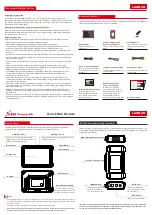
KEENAN MechFiber300 Operator’s Manual
21
Revision F01 06
th
March 2020
7.7 Specific instructions for Bale handler models
1. The creel should be raised before loading bales.
2. The bale (round bales) should always be loaded in the centre of
the machine so that it gets the maximum agitation from the six
paddles.
3. The bale should be gently lowered in the centre of the machine
onto the tines. The Bale handler will then begin its cutting action, with the tines working in
conjunction with the top knife, body blades and six paddles to evenly chop the bale material
in a timely manner. The bale should be chopped evenly throughout this process which will
avoid large lumps of the bale entering the mixer at any time. This will result in a better mix
quality and more even chopping action.
4. After the bale has been fully chopped and entered into the machine the next bale can be
added to the mix in the same manner as above.
5. The standard chopping times for different materials of round 4x4 (120 cm) bales are as
follows:
Bale:
Time:
Straw
6
–8 minutes (140 kg)
Hay
4
–6 minutes (300 kg)
Wet silage (up to 20% DM)
2
–4 minutes (700 kg)
Dry silage (20%
–30% DM)
4
–5 minutes (500 kg)
Very dry silage (over 35%)
4
–6 minutes (400 kg)
Note:
Heavy bales must be loaded gently on to the Bale handler,
not dropped from a height, or damage may occur.
6. These times are achievable if the bale is loaded in the correct
position and the loading method, as described above, is followed.
These times may vary slightly depending on the tightness of the
bale and the behaviour of the bale when it is being chopped.
7. When loading large square bales, the method is to load the bale
so that the sections lie across the tines
so as to prevent the
sections falling through the gap in the tines (see diagram to the
right: sections of large square bale loaded perpendicular to the
tines. The easiest way to do this is to load the bale in two halves
on the loader (one half in each side of the bucket, if wide enough)
and flick the sections out onto the tines. In this way the sections
will remain up on the tines for longer and get a better chop against
the top knife. If loaded the opposite way the sections will tend to
fall through the tines, not get chopped and cause additional stress
on the chopping mechanism.
8.
The key to the successful operation of the Bale handler is that the bale remains on top
of the tines long enough to allow the pre-chopping to take place against the serrated top
knife. This ensures that the amount of further chopping within the mixing chamber is
reduced, and though it may take longer for the bale to be taken in, during this time the
material that has already been cut from the bale is being processed within the chamber.
Incorrect
Correct
Summary of Contents for 30L100
Page 36: ...KEENAN MechFiber300 Operator s Manual 36 Revision F01 06th March 2020 PART II Spare Parts ...
Page 44: ...KEENAN MechFiber300 Operator s Manual 44 Revision F01 06th March 2020 ...
Page 56: ...KEENAN MechFiber300 Operator s Manual 56 Revision F01 06th March 2020 ...
Page 57: ...KEENAN MechFiber300 Operator s Manual 57 Revision F01 06th March 2020 ...
Page 58: ...KEENAN MechFiber300 Operator s Manual 58 Revision F01 06th March 2020 ...
Page 59: ...KEENAN MechFiber300 Operator s Manual 59 Revision F01 06th March 2020 ...
Page 77: ...KEENAN MechFiber300 Operator s Manual 77 Revision F01 06th March 2020 ...
















































